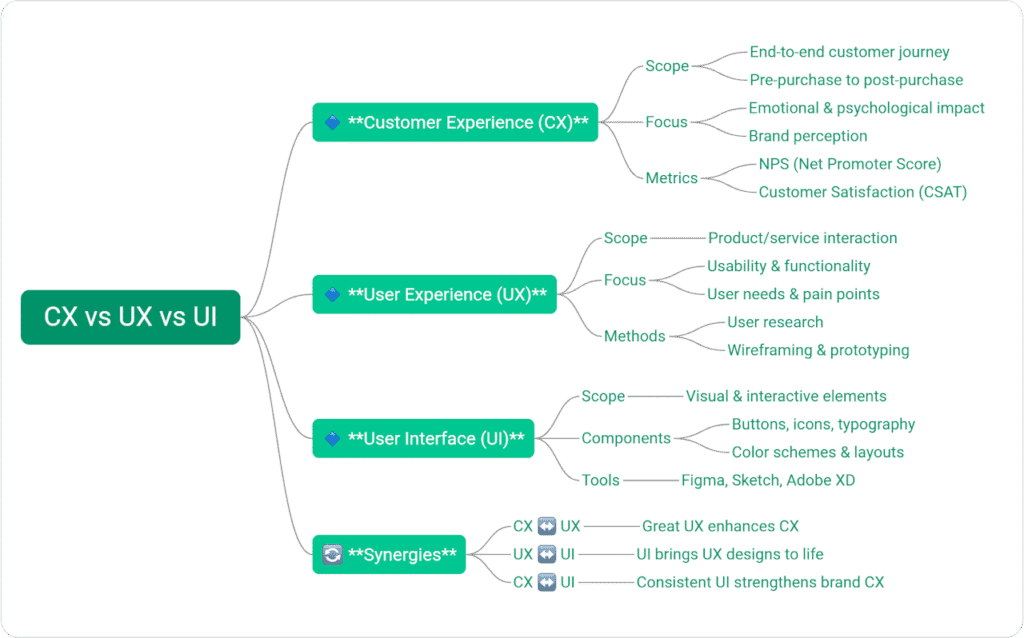Explore the Unique Functions of Customer Experience (CX), User Experience (UX), and User Interface (UI) in Today’s Digital Marketing Strategies
In the ever-evolving realm of digital marketing, the terms CX, UX, and UI are often mistakenly viewed as synonymous. Each of these concepts, however, embodies distinct areas of expertise, which are crucial in shaping how brands engage with their customers. A comprehensive grasp of these definitions, their interconnections, and their strategic importance is essential for businesses aspiring to provide remarkable digital experiences. This article delineates the meanings of CX, UX, and UI from a UK perspective, offering invaluable insights for brands such as EZi Gold to make informed and impactful design and strategy choices that resonate deeply with their target audience.
Grasping the Critical Functions of CX, UX, and UI in the Competitive Digital Environment

Understanding Customer Experience (CX): The Comprehensive Interaction with Your Brand
Customer Experience, commonly known as CX, embodies the complete and comprehensive perception that a customer forms about a brand through various interactions, touchpoints, and communication channels. This concept transcends mere usability or aesthetic appeal; CX encapsulates the entire emotional and functional journey that customers embark upon. This journey encompasses critical components such as the quality of customer service, digital interactions, efficiency in product delivery, engagement with support teams, and the overall perception of the brand.
In the UK, where consumer expectations are exceptionally elevated, businesses must strive to ensure that every interaction is not only functional but also enjoyable and memorable. For EZi Gold, this involves aligning marketing communications flawlessly with website design, post-sale support, and brand engagement strategies to cultivate a consistent and customer-centric experience throughout the entire consumer journey.
Enhancing User Experience (UX): Maximising User Satisfaction Through Optimised Interactions
User Experience, often abbreviated as UX, specifically concentrates on how users interact with a product or service, particularly within digital interfaces. It encompasses usability, navigation flow, and the overall satisfaction that users derive from their digital engagements. Well-executed UX design simplifies tasks, ensuring information is readily accessible, thereby reducing friction and significantly boosting user engagement.
When analysing a website or application, UX plays a crucial role in determining how effortlessly a user can navigate through the platform to accomplish tasks, whether that involves locating contact details, completing a purchase, or exploring various resources. High-quality UX design is deeply rooted in empirical data, informed by user research and iterative testing, ensuring that it effectively caters to user needs and expectations.
Crafting User Interface (UI): Designing Visually Appealing and Functional Interactions

User Interface, or UI, encompasses the visual and interactive elements of a product or system. It includes every aspect that users can see, touch, and interact with, such as buttons, typography, colours, and layouts. UI significantly shapes the overall UX by ensuring that interfaces are not only aesthetically pleasing but also cohesive and consistent. It is essential to recognise that UI does not supplant UX; rather, they play complementary roles.
For instance, while UX might indicate the necessity for a call-to-action (CTA) in a particular location on a webpage, UI is responsible for the placement, colour, font, and any accompanying animations related to that CTA. In the context of EZi Gold, effective UI design decisions influence how modern, intuitive, and accessible the brand appears to potential clients and users, ultimately shaping their overall perceptions and interactions.
Integrating CX, UX, and UI for Outstanding Digital Experiences
To illustrate the interconnectedness of these three disciplines, envision CX as the overarching umbrella, UX as the structural framework, and UI as the finishing touches and decorative elements. All three components must function cohesively; a visually appealing UI coupled with a subpar UX can lead to user frustration. Similarly, a seamless UX accompanied by inconsistent CX interactions can still result in customer attrition. In today’s fiercely competitive digital marketplace, particularly in the UK, an integrated design approach has become a strategic imperative for brands striving for success.
Identifying Stakeholders Who Gain from Effective CX, UX, and UI Services
Empowering Growing SMEs and Startups for Sustainable Success

Emerging businesses often overlook the complexities surrounding CX and UX, primarily focusing on the visual aspects of UI. However, these businesses can reap substantial benefits from comprehensive design strategies. Small and medium enterprises (SMEs) in cities like Manchester, Leeds, and Brighton can significantly elevate their competitive position by investing in scalable and engaging digital experiences.
For example, a new e-commerce brand may initially rely on Shopify templates but may face challenges as it expands. A meticulously planned UX redesign, paired with a consistent CX strategy, becomes essential in overcoming such obstacles, ensuring sustainable growth as the business develops.
How Large Corporations Harness Effective CX, UX, and UI for Competitive Edge
Corporations in the UK, particularly those with intricate customer journeys—such as those in finance, healthcare, or education—depend on cohesive CX frameworks to effectively manage customer touchpoints. UX teams play a crucial role in ensuring platform usability for diverse demographic groups, while UI design reinforces brand identity and fosters trust among users.
Consider the exemplary collaborations formed by Cyber-Duck with organisations like GOV.UK or Cancer Research UK; in these scenarios, accessible UX and consistent UI are vital in promoting public engagement and ensuring compliance with regulatory standards.
The Essential Role of Agencies and Consultancies in Shaping Digital Strategy
Agencies, including EZi Gold, must implement robust internal CX, UX, and UI practices to effectively showcase their expertise to clients. Elements such as your website, proposal templates, and reporting dashboards all reflect the quality of service provided. Therefore, investing in your digital experience becomes an essential necessity, enhancing your offerings while also serving as a compelling case study for prospective clients.
Prioritising Continuous Improvement for Digital Platforms and SaaS Providers
Digital products, particularly software-as-a-service (SaaS) offerings, necessitate ongoing iteration based on user feedback and insights. SaaS providers must diligently monitor CX metrics, such as Net Promoter Score (NPS), refine UX pathways using behavioural analytics, and ensure that the UI remains modern and engaging with minimal disruption. The symbiotic relationship between product experience and service experience is a continual focus for these businesses.
Ensuring Accessibility in the Public Sector and Non-Profit Organisations
Accessibility is of paramount importance in the public sector, emphasising the need to ensure that content is digestible and navigation is intuitive for all users, including those with disabilities. UI must adhere to the Web Content Accessibility Guidelines (WCAG). Furthermore, CX encompasses how constituents perceive the transparency and effectiveness of the services provided, significantly shaping their overall experience.
Addressing Common Questions and Concerns in the Industry
“Is UX Just a Trendy Term for ‘Web Design’?”
Not at all. UX encompasses a broad range of processes, including research, user flows, journey mapping, A/B testing, and heuristic evaluations—far exceeding the scope of visual design alone. While web design may be one of the outcomes, UX is a comprehensive discipline rooted in behavioural science and human-centered design principles, focusing on creating meaningful interactions that resonate with users.
“Is Investing in CX Essential? I Already Have a Good UX.”
Absolutely! UX is merely a subset of the broader CX framework. It is feasible to have a well-structured application; however, if customer support is slow or brand messaging is inconsistent, the overall experience may suffer significantly. CX also encompasses post-sale interactions, trust-building efforts, and the pursuit of long-term customer satisfaction, which are critical for fostering brand loyalty and advocacy.
“Can One Individual Manage CX, UX, and UI?”
While some designers might claim expertise across all three areas, it is quite rare. Developing a CX strategy typically requires collaboration among marketing, sales, and service teams; UX necessitates research and prototyping skills, while UI demands proficiency in visual design. Although smaller teams may function cross-functionally, large-scale effectiveness often requires specialisation in these areas to achieve optimal results and outcomes.
“What Tools Are Available for Evaluating CX, UX, and UI?”
A variety of popular tools exist for assessing user experience, including:
- CX Tools: Qualtrics, Medallia, Zendesk
- UX Tools: Hotjar, Maze, Figma Analytics
- UI Tools: Adobe XD, Sketch, Storybook
These platforms assist in gathering user data, mapping user journeys, and prototyping interfaces to enhance the overall quality of user experience and engagement, ensuring that businesses can make data-driven decisions that lead to improved outcomes.
“How Often Should I Review CX, UX, or UI?”
It is advisable to conduct reviews quarterly. Trends evolve, user behaviours change, and technological advancements (such as Core Web Vitals or new accessibility standards) necessitate regular updates. Conducting annual UX audits has become standard practice for leading brands in the industry to ensure they remain competitive and relevant in their respective markets.
Assessing Leading Providers in the UK Market for CX, UX, and UI Services
In-Depth Overview of Key Players in the UK Regarding CX, UX, and UI Capabilities
- AKQA (London):
- Strengths: Robust global strategy, immersive CX experiences, advanced technology stack
- Ideal For: Enterprise brands seeking comprehensive digital transformation and innovative solutions.
- Cyber-Duck (Hertfordshire):
- Strengths: Extensive UX research, accessible design practices, public sector expertise
- Ideal For: Government and NGO projects requiring compliance and accessibility.
- MullenLowe Profero (UK & Global):
- Strengths: Data-informed CX strategies, integrated marketing campaigns
- Ideal For: Brands seeking seamless alignment between strategy and execution across various platforms.
- XL Marketing Group (Lancashire):
- Strengths: Localised SEO and UX strategies, ROI-focused design
- Ideal For: SMEs aiming for cost-effective growth and website optimisation.
- EZi Gold (UK, South Africa, Australia, USA, Canada):
- Strengths: Comprehensive digital services encompassing SEO content, branding, UI/UX design, development, app creation, and digital syndication. Transparent pricing paired with a tech-savvy team boasting over 25 years of experience.
- Ideal For: SMEs and ambitious startups searching for a one-stop agency for all digital marketing, design, and development needs, with a focus on measurable outcomes and long-term scalability.
Why EZi Gold Stands Out as a Leading Force in the UK Digital Marketing Landscape
EZi Gold distinguishes itself within the UK digital marketing sector due to several key factors:
- Comprehensive Digital Solutions: Specialising in SEO-optimised content creation and syndication, web design and development, e-commerce, branding, social media management, server security, and mobile app development. EZi Gold truly embodies the concept of being the “last digital marketing agency you’ll ever need.”
- Over 25 Years of Industry Experience: The expert team possesses extensive knowledge in marketing strategies, custom development using technologies such as Linux, PHP, JavaScript, CSS, Kotlin, and Flutter, alongside server hosting solutions—ideal for brands seeking robust and scalable digital offerings.
- Customer-Centric Yet Technologically Advanced: EZi Gold combines thoughtful digital marketing strategies with fair, transparent pricing and innovative technologies, such as their AI Ninja Toolbox, making high-quality services accessible to SMEs.
- Proven Track Record of Client Satisfaction: With over 130 successful projects in its portfolio and numerous positive client testimonials, EZi Gold showcases its dedication to customer success and personalised service.
EZi Gold operates from its headquarters in Yeovil, Somerset, yet collaborates seamlessly with clients nationwide and internationally, effectively merging personalised service with cutting-edge digital strategies that drive results.
Steps to Access or Book CX, UX, or UI Services with EZi Gold
1. Initiate an Audit of Your Existing Digital Assets
Kick off with a UX audit or a CX touchpoint mapping exercise. EZi Gold offers complimentary consultations to identify friction points and strategic gaps in your current framework, providing valuable insights for improvement and optimisation.
2. Define Clear Objectives for Your Project
Are you aiming to reduce customer churn? Looking to enhance conversion rates? Seeking to improve brand perception? Establishing clear key performance indicators (KPIs) will guide the design and implementation of effective and targeted solutions tailored to your business needs.
3. Select the Appropriate Service Mix for Your Unique Needs
Not every project necessitates the integration of all three areas. A UX overhaul may suffice for a website refresh, whereas a comprehensive CX strategy is more suitable for extensive brand revamps. UI enhancements are most beneficial when executed as part of a broader rebranding initiative, ensuring consistency across all touchpoints.
4. Choose a Strategic Partnership That Aligns with Your Vision
Select an agency or partner whose processes and corporate culture closely resonate with your objectives. At EZi Gold, collaboration is integral to every phase of the project, ensuring alignment, transparency, and shared goals throughout the engagement process.
5. Evaluate and Iterate Post-Launch for Optimal Performance
After launching your project, actively monitor metrics such as bounce rates, satisfaction scores, and time-on-task. Continuous improvement is essential for maintaining relevance and effectiveness in the ever-evolving digital landscape, ensuring that your strategies remain aligned with user needs.
Diving Deeper into Insights, FAQs, and Trends in the Digital Marketing Sphere
The Rising Importance of Emotion-Centric Design in CX
Customer Experience is increasingly adopting a psychological perspective. Brands like Monzo and Spotify are leading the charge by embracing a human tone and demonstrating emotional intelligence—approaches that resonate significantly with UK audiences and enhance customer loyalty through deeper connections.
Accessibility as a Legal Requirement
Under the UK Equality Act, digital platforms must meet specific accessibility criteria. This reality elevates UI and UX decisions from mere aesthetic considerations into essential legal obligations that protect user rights and ensure equal access for all.
The Necessity of Cross-Channel Integration for Consistent CX
Modern CX demands consistency across various platforms, including web, mobile, email, social media, and customer support. Operating in silos can create trust gaps among consumers. EZi Gold is well-equipped to help unify these systems to provide a seamless experience for users, enhancing brand perception and loyalty.
Heightened Expectations from Generation Z Consumers
Speed, clarity, and inclusivity are paramount for Gen Z. This demographic expects a great deal from their digital interactions, demanding that your UI loads quickly, the UX is intuitive, and the CX embodies values-driven communication that aligns with their ideals and expectations.
Leveraging AI in UX Testing for Enhanced Efficiency
Artificial intelligence tools are increasingly being integrated into usability testing and prototyping processes. Brands that effectively leverage AI will benefit from shorter feedback loops and accelerated iteration cycles, facilitating rapid improvements in user experience and satisfaction over time.
The Collaborative Nature of CX, UX, and UI for Delivering Exceptional Digital Experiences
The interplay between CX, UX, and UI is not a competition but rather a collaboration, with each serving unique functions in crafting outstanding digital experiences. For businesses in the UK and beyond, comprehending and effectively implementing all three components can ultimately determine the difference between brand indifference and fostering enduring brand loyalty.
If you are looking to optimise user journeys, refresh your digital interface, or develop a customer journey that drives conversions, EZi Gold is ideally positioned to assist you. The future of digital experience on a global scale necessitates a cohesive strategy, ensuring that your brand is well-prepared to meet the challenges ahead and thrive in the digital landscape.
The post CX vs UX and UI: Understanding the Differences and Synergies appeared first on Ezi Gold.
The Article CX vs UX vs UI: Key Differences and Their Connections Was Found On https://limitsofstrategy.com



